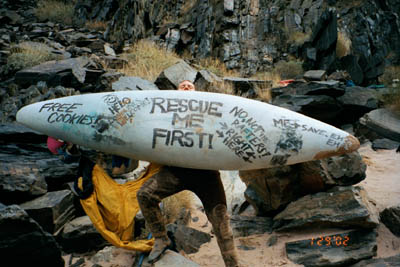
Visibility can be an important factor in gear design.
Design Considerations
We think that Rudolph Giulianni once said "two elephants for a quarter is only a good deal if you need two elephants and you have a quarter." For us, that philosophy applies pretty well to gear.
The Big Question: What do you need it for?
Application is the light at the end of the tunnel, and we try not to lose sight of it. No matter what cool doo-dahs we find on gear, we try to ask ourselves, at every stage: Is this what I need? Will I use this? Do I care about these features?

Visibility can be an important factor in gear design.
APPLICATION-RELEVANT CRITERIA:
You may wish to consider your gear for some or all of the following criteria. Since this is intended as a fairly comprehensive list, many criteria may not apply to specific need. You might want to write down the factors you see as relevent, and carry that list with you when you go shopping, or when you sit down to build/modify what you already have. In fact, we find a pen and paper one of the best tools out there for finding & getting what we want.
Any or all of the above factors might be relevent. Poking, prodding, and trying out the gear is invaluable, but we also want to emphasize two vital steps in the process:
General Feature Considerations
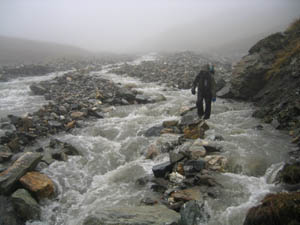
What do you consider "normal" gear stress?
This is a little rant space for us. For more specific gear considerations, we refer you to Gear Reviews.
ZIPPERS Zippers are potential failure point and an entrance for water and wind. Is this a concern for you? Some zippers are water resistent, while others - equipped with mating rubber - are waterproof. Consider whether the zipper is heavy enough, and/or if proper use of the item will place strain on the zipper. A light zipper that's never strained is often more reliable than a heavy zipper forced to hold 60 pounds. Zippers also add weight. Metal zippers are more durable, but plastic zippers weigh less.
FABRIC WEIGHT
Fabric that's too light for the intended use will fail, but fabric that's too heavy adds weight and bulk. This adds up, especially on something as large as pack or tent.
RIPSTOP vs. NON-RIPSTOP
We have yet to find a situation where non-ripstop fabric is better. Nothing makes us sadder than seeing the rip at our ankle propogate to our crotch.
COLOR MATTERS
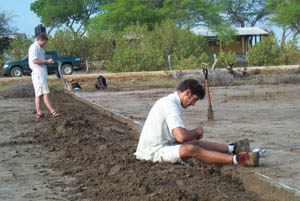
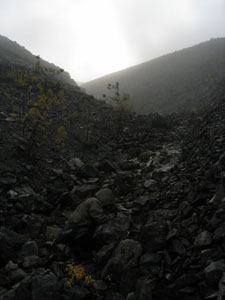
Left: Beyond Spec's Science Minions Wear white cotton during a Nicaragua tsunami survey, too keep cool.
Right: Beyond Spec's Ninja Mistress uses "sage" gore-tex vanishing into a rocky gully in Artic National Wildlife Refuge.
Color, texture, contrast, and shine can all affect your visibility as well as the heat-absorbing properties of your outfit. Appearance also has deeply rooted social implications, whether it's a full camo outfit or just magenta ear muffs. Rules of thumb:
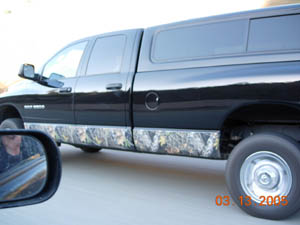
SEAM LINES
Seams lines are weak points in any fabric item. If a garmet is going to blow it, it will usually blow out at a seam. If water is going to enter, it will usually enter through a seam. Look at the way the seams are stressed when you move. If you place undue stress on a particular seem, consider the possibility that it will fail. A common failing, for instance, is in the crotch of pants after repeated squatting. Consider reinforcing the seam, modifying it, or simply buying something else.
Seam lines can also be source of chafe, particularly where belts or packs press them into the skin.
POCKETS
A few strategic exterior pockets can be very handy. Consider their utility, either when buying gear or making it. What do you need to store? Pockets can also be ways for water or wind to enter your garmet or pack. Brush can snag on them.
DRAINING
A product's water-resistant qualities are often touted, but not necessarily its draining properties. Draining can sometimes be more important than waterproofing. Will water move quickly out of the clothing, shoe, pack, etc.? Does the item in question dry fast, or does it have thick seams and piles of fabric that hold water?
Some draining problems are easy to remedy. The chief author had some cheapo rainpants that, thanks to the liner, filled with water during every river crossing and transformed into the Huge Weighted Bell-Bottoms from Hell. A few knife-rents in the base of each ankle solved this problem handsomely.
VELCRO
Good velcro holds up very well, in our experience, but the second-rate stuff is a nightmare. Check the velcro on any new purchase, and when building your own gear, take the time to scrounge good velcro. Keep velcro mated whenever possible, even if the garmet, etc., isn't in use. Thus protected, the velcro will last longer.
STRAIN POINTS
Look at where heavy use will strain any and every item. Are the strain points are well-reinforced?
COMPLEXITY
Overall principle: the more complicated something is, the more ways there are for something to go wrong with it. Consider Murphy's Law.
| Gear Reviews | Understanding Gear | Ensembles & Kits |
|---|